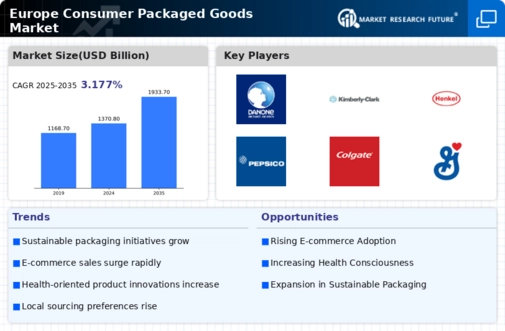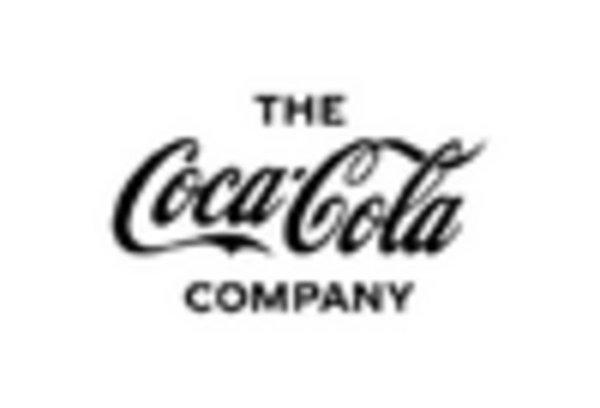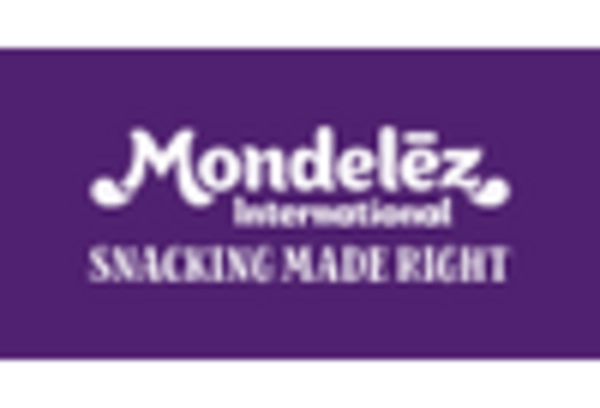Evolving Consumer Preferences
The consumer packaged-goods market in Europe is currently experiencing a shift in consumer preferences, driven by a growing demand for convenience and quality. Consumers are increasingly seeking products that align with their lifestyles, which has led to a rise in ready-to-eat meals and premium offerings. According to recent data, the market for convenience foods has expanded by approximately 15% over the past year, indicating a strong trend towards on-the-go consumption. This evolution in preferences compels manufacturers to innovate continuously, ensuring that their product lines meet the changing demands of consumers. As a result, companies are investing in research and development to create products that not only satisfy taste but also cater to the convenience factor, thereby enhancing their competitive edge in the consumer packaged-goods market.
Rising E-commerce Penetration
The rise of e-commerce is transforming the consumer packaged-goods market in Europe, as more consumers turn to online platforms for their shopping needs. Recent statistics reveal that online grocery sales have surged by over 30% in the past year, reflecting a significant shift in consumer behavior. This trend is not only reshaping distribution channels but also influencing marketing strategies, as brands increasingly invest in digital advertising and online engagement. The convenience of home delivery and the ability to compare products easily are driving this change. Consequently, companies are adapting their logistics and inventory management to cater to the growing demand for online shopping, which is likely to continue shaping the landscape of the consumer packaged-goods market.
Sourcing and Supply Chain Dynamics
The dynamics of sourcing and supply chains are pivotal in the consumer packaged-goods market in Europe. With increasing pressure on sustainability and ethical sourcing, companies are re-evaluating their supply chains to ensure they align with consumer values. A recent survey indicated that approximately 70% of consumers prefer brands that demonstrate a commitment to ethical sourcing practices. This trend has prompted businesses to establish more transparent supply chains, often involving local sourcing to reduce carbon footprints. Additionally, disruptions in global supply chains have led to a renewed focus on resilience and flexibility, compelling companies to diversify their supplier base. Such strategic adjustments are essential for maintaining competitiveness in the consumer packaged-goods market.
Regulatory Compliance and Standards
The consumer packaged-goods market in Europe is significantly influenced by stringent regulatory frameworks and standards. The European Union has implemented various regulations aimed at ensuring product safety, quality, and environmental sustainability. Compliance with these regulations is not merely a legal obligation but also a market differentiator. Companies that adhere to these standards often gain consumer trust and loyalty, which is crucial in a competitive landscape. For instance, the introduction of the EU's General Food Law has necessitated that businesses maintain high levels of transparency and traceability in their supply chains. This regulatory environment may pose challenges for smaller firms, yet it also presents opportunities for larger companies to leverage their resources to ensure compliance, thereby enhancing their position in the consumer packaged-goods market.
Technological Advancements in Production
Technological advancements are reshaping the consumer packaged-goods market in Europe, particularly in production and supply chain management. Automation and smart manufacturing technologies are being adopted to enhance efficiency and reduce costs. For example, the integration of artificial intelligence in inventory management has shown to decrease waste by up to 20%, allowing companies to respond more swiftly to market demands. Furthermore, advancements in packaging technology are enabling longer shelf life and improved product safety, which are critical factors for consumer acceptance. As these technologies continue to evolve, they are likely to drive innovation and competitiveness within the consumer packaged-goods market, allowing companies to meet the increasing expectations of consumers.

















Leave a Comment